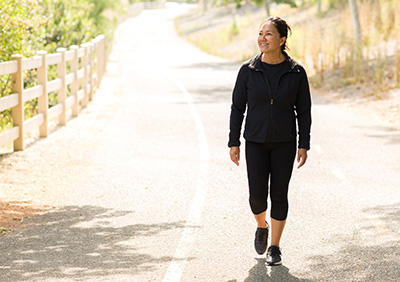Walk for Your Health
Posted: January 31, 2022 | By: Stacy Croninger

There are many ways to move your body. Some require special equipment (like weights or a pool) or going to a gym or rec center. The great thing about walking is you have everything you need – shoes, feet, and ground. You don’t even have to leave your house if you don’t want to, just walk around your house. If that’s not enough reason to start walking, we’ll look at how it benefits your joints and weight.
Overall Benefits
Because walking is so readily available, it offers several benefits, two of which we’ll look at a little closer. According to Integris Health, these are some of the health benefits of walking:
- Keeps your joints strong and lubricated, which if you have arthritis, can also help reduce symptoms
- Help reduce stress and improve your sleep patterns, which helps your mental health
- Helps manage heart disease, high blood pressure, high cholesterol and diabetes.
- Can help reduce the number of sick days
Walking and Your Joints
According to Arthritis.org, “The majority of joint cartilage has no direct blood supply. It gets its nutrition from joint fluid that circulates as we move. Movement and compression from walking “squishes” the cartilage, bringing oxygen and nutrients into the area.” Walking is a low-impact exercise, meaning it doesn’t put a lot of pressure on your joints, which makes it ideal for anyone to do.
In addition, walking can stop the loss of bone mass. This is really important if you have osteoarthritis or are a post-menopausal woman.
Walking and Your Weight
How many calories you burn each day depends on your age, height, and weight, but a 30 minute walk could burn 150 or more calories a day. (Mayoclinic.org) And as you walk loner and faster, you’ll burn additional calories. But it is important to have balance so that you don’t overdo it and cause injuries or burnout, which is often related to soreness. In the following information, we’ll outline the best way to start walking, if you aren’t already, to help minimize these issues.
Even if you don’t lose a lot of weight, remember that you are gaining other benefits.
How to Walk
Yes, you’ve been walking since you were a small child, but there are things that you can do to improve your walking. You’ll be amazed at what a few simple changes can do.
First, make sure you have good posture. Integris Health suggests:
“Hold your head up straight over your shoulders, being sure not to tilt it down – this means don’t stare down at your phone when walking! Relax your shoulders, neck and back and keep them in a natural position.
With each step, swing your arms and slightly bend your elbows. You want your arms and hands relaxed, but not too relaxed to the point of dangling at your side. Engage your core as you walk. You can practice this by squeezing your abdominal muscles as if you’re about to receive a gut punch. In terms of foot strike, roll your foot from heel to toe in a smooth fashion.”
Also, make sure your stride is not too short or too long, as this can make your walks less effective.
Second, you may want to invest in a quality pair of shoes. If you’re walking around your house or a few blocks, it may not be as critical, but walking several miles a day requires good support for your feet.
Getting Started
If walking is new to you, start small and build up. Walk around your house or one block, then expand to two blocks, and so on until you’re walking 30-60 minutes a day. Speed is not critical, but you may find that changing up your routine (walk normal for 5 minutes and fast for 3 minutes) can help burn more calories and make your walk more interesting. If you get bored with your walking, try walking in a mall or around a park – changing your environment helps keep you walking.
For additional accountability, join the Better Health Challenge and join the Facebook Group where they post tips and ideas for making the most of your healthy habits.
For now, grab your shoes and start walking. Your body will thank you!
Posted in:

